Teaching & Learnign
Reflection in learning design: Part of the process and potentially an outcome – Teaching Matters blog. In this post, Tobias Thejll-Madsen, from the University’s Employability Consultancy and co-author of the Reflection Toolkit, proposes a place for reflection within effective course and programme design – both in the design phase and in courses themselves… What is the best course you were ever a part of?
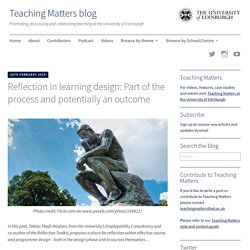
Why was that? What was it about the teaching activities or the way the content was presented that engaged the learners? Why did this work better than alternatives? I think most people, perhaps yourself included, have experienced a potentially exciting topic presented in a way that it almost lulled you to sleep, yet have also had a topic that you expected to find dull brought to life in a new and interesting way. The opening questions in this post ask you to examine your own experiences of being a learner on a course, and to consider the reasons behind your answers. Reflection within the curriculum. LdShake. How to Make Teaching more Effective? – ALU Global Focus. Education is an enlightening experience.

It brings an integrating permanent change in one’s thinking and capacity to do things. According to Bell Hooks, “education was about the practice of freedom” (Hooks, 1994). Knowledge has no end, but it only grows from time to time. Solomon Ortiz said, “Education is the key to success in life, and teachers make a lasting impact in the lives of their students.”
Course Design Model - RASE. Learning design and student engagement Learning design and the need for student engagement requires a practical, evidenced-based course design model with applications of technology to improve student learning outcomes and student satisfaction. The student-centered learning design model is called RASE. The model has four components: Resources, Activity, Support and Evaluation (RASE) (Churchill, King, & Fox, 2013).
Higher Education Digital Capability Framework. Moodle. Preamble [Question] ‘Is your learner TEL environment becoming increasingly challenging to improve?’
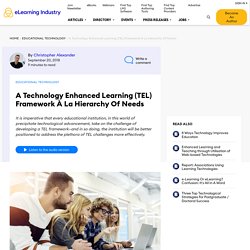
[Answer] ‘Yes?’
[Reply] ‘You need a TEL framework; so read on…’ Framework Overview The diagram below presents some key generic questions at each level of the framework. In a sense, the framework resonates with the Maslow’s Hierarchy of Needs' Pyramid, because: without sufficient institutional engagement, the detailed researching (NB including trialling/testing) of learning technologies, CPD and learner success in the TEL environment cannot be ‘achieved’ effectively (see section 2.1 for more discussion on the institution);without the sufficient researching of learning technologies, CPD and learner success in the TEL environment cannot be ‘achieved’ effectively (see section 2.2 for more discussion on researching learning technologies);without sufficient CPD, learner success in the TEL environment cannot be ‘achieved’ effectively (see section 2.3 for more discussion on CPD). 1. 2. 2.4 The Learner.
7 Ways UX Design Theory Transformed My Approach to Course Design. Assessment Design and Evaluation. The assessment of student learning is at the heart of the education enterprise.
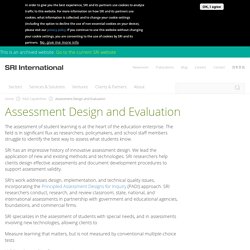
The field is in significant flux as researchers, policymakers, and school staff members struggle to identify the best way to assess what students know.
GSIC/EMIC - Home. The Group of Intelligent & Cooperative Systems / Education, Media, Informatics & Culture (GSIC/EMIC) is a transdisciplinary group which is composed by teachers, researchers and staff of the School of Telecomunications Engineering, School of Computer Engineering, and Faculty of Education & Social Work at the University of Valladolid.
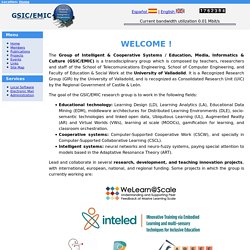
It is a Recognized Research Group (GIR) by the University of Valladolid, and is recognized as Consolidated Research Unit (UIC) by the Regional Government of Castile & León. The goal of the GSIC/EMIC research group is to work in the following fields:
SOLE Toolkit 3.5 – Dr Simon Paul Atkinson PFHEA. Released 30th May 2015 SOLE Toolkit remains a free, unprotected and macro-free Excel workbook with rich functionality to serve the learning designer.
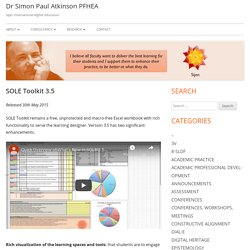
Version 3.5 has two significant enhancements.
Google debuts ‘Code with Google’ coding education resource for teachers. Google is offering a new coding resource for educators via Code with Google, which collects Google’s own free course curriculum on teaching computer science and a variety of programs to help students learn to code or build on their existing skills, with stuff for people at all levels of ability.
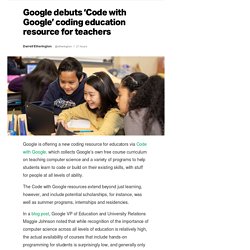
The Code with Google resources extend beyond just learning, however, and include potential scholarships, for instance, was well as summer programs, internships and residencies.
Learning Analytics and Learning Design. Design Thinking for Educators. How do you motivate students to watch the video lectures in a...
The new UNESCO Recommendation on Adult Learning and Education (2015)
Influential theories of learning. Learning is defined as a process that brings together personal and environmental experiences and influences for acquiring, enriching or modifying one’s knowledge, skills, values, attitudes, behaviour and world views.

Learning theories develop hypotheses that describe how this process takes place. The scientific study of learning started in earnest at the dawn of the 20th century.
T Archives - The Glossary of Education Reform Archive. Design Thinking for Educators.
BOOKS
Technology, Knowledge and Learning, Volume 22, Issue 3 - Springer. The New National Education Technology Plan: What’s in it for Me? - Future Ready Schools. In December of 2015, on the same day that President Obama signed the “Every Student Succeeds Act” (ESSA), the U.S.
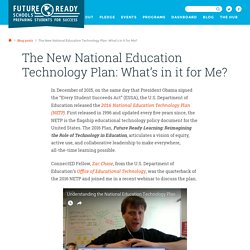
Department of Education released the 2016 National Education Technology Plan (NETP). First released in 1996 and updated every five years since, the NETP is the flagship educational technology policy document for the United States.
Towards a Teaching Analytics Tool for Supporting Reflective Educational (re) Design in Inquiry-Based STEM Education - IEEE Conference Publication.
Data Science and LA
Debates. Evaluation and assessment. Gamification. Learning Analytics. Learning Design. Learning Theories & Pedagogies. Student presentation. Learning patterns. Latinoamerica. MOOCS. Outcome-Based assessment. Scenario Based Learning. Student Agency. Rubrics. Taxonomy. Teaching Inquiry & Evidence Base Design. Teoricos y filosofos. Universal design. Professional Development. Slide-share. TEL Software. Learning Pathways. Untitled. eLearning Papers #42 on "Design Patterns for Open Online Teaching and Learning" has just been published.
The rapid rise of massive open online courses (MOOCs) has renewed interest in the broader spectrum of open online teaching and learning.
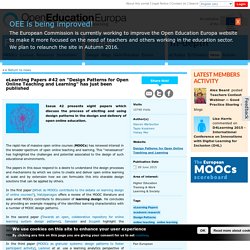
This “renaissance” has highlighted the challenges and potential associated to the design of such educational environments. The papers in this issue respond to a desire to understand the design processes and mechanisms by which we come to create and deliver open online learning at scale and by extension how we can formulate this into sharable design solutions that can be applied by others.
Reflections on Learning Design Process Models 1. Over the last month, Rebecca Galley, Paul Mundin and I have been reflecting on a range of our recent meetings and project related activities (including meeting with colleagues from Birmingham City and Gloucestershire, with our external partners, and OU colleagues).
This post shares some of this ‘reflection-in-progress’ and as such uses languages familiar to those exploring new structures for curriculum/learning design processes. Here are two different draft representations to help communicate our interpretation of recent work. I think it important that such models seek to weave together the less formal practices and processes (such as design activities) with more formal and necessary demands: If you click on the images an enlarged version should load. By way of explanation, these representations were the outcome of our thinking about a range of questions.
Capture knowledge, share files, and manage projects within a secure, reliable environment.
Lectura Un marco para elearning1. E-Learning Framework for Massive Open Online Courses (MOOCs)
Massive Open Online Course MOOC model – framework Dr. Robert Doyle, Harvard University, USA uses Khan’s MOOC Framework for his Paris presentation entitled “Why We MOOC: Philosophy and operations of HarvardX and EdX”
B-MOOC » 4 steps to Build MOOC. Depending on corporate objectives and value creation target, we assist our clients in building, for MOOC environments, the appropriate Course design, Course materials and Interface design.
We are used to establish and animate a pedagogical team that can includes one or several trainers, mutli-disciplinary and international internal or external experts. With pedagogical engineers, we always start from an existing content and an existing training team, and all together as the “pedagogical team” we build the following outputs :
Mod4L. OpenLearn Works. ASK: Advanced Digital Systems and Services for Education and Learning. Articulación Teorias del Aprendizaje, Diseño Instruccional y Diseño Tecnopedagógico timeline. Michael Horn: "Using Disruptive Innovation like Blended Learning to Improve Schools"
Doodle3D - 3D design made easy.
10 Instructional Design Elements To Include In EVERY eLearning Course - eLearning Industry. Welcome to The Langley Academy. How to make your own MOOC! (Well...quasi-MOOC)
UDL/Differentiated Instruction - SPED Strategies and Resources. Differentiated instruction (DI) is a process by which teachers get to know their students so that they can accommodate them in learning.
Learning design at the University of Queensland, Australia.
BengioETAL12. IIEP UNESCO. 20 eLearning Blogs You Simply Have to Bookmark. In our own, considered, humble opinion, we have an awesome blog that every eLearning professional should read. But sometimes we like to see what our colleagues are doing, which means taking a look at the multitude of eLearning knowledge that exists all over the web.
ED529952. Homepage. PNNL: Cognitive Informatics - Interactive Assessments. Representations of Effective Practice. In the UK a number of initiatives are representing the structure and orchestration of activities in a variety of forms. These include the Higher Education Academy subject centres, CETLs, TESEP, Learning Activity Design in Education (LADIE, part of the JISC eFramework Programme), the JISC Digital Libraries in the Classroom programme (DIDET and DialogPlus) as well as the JISC Effective Practice and Innovative Practice guides.










